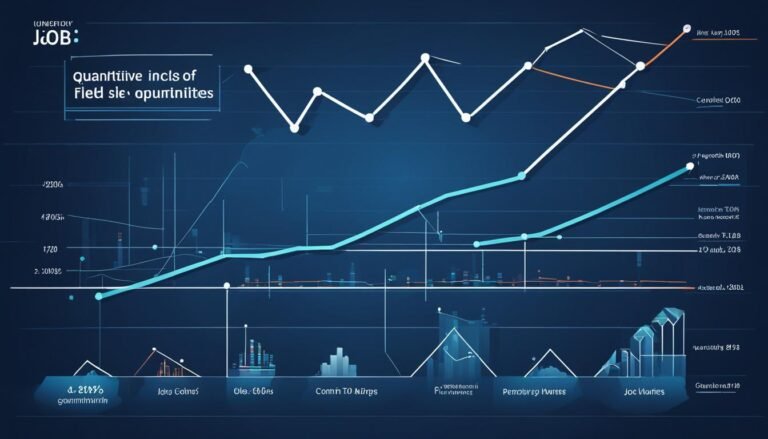Fintech Innovations for Quants
Like a navigator with a cutting-edge compass, you're on the brink of discovering how fintech innovations are reshaping the landscape for quants. From advanced data visualization tools to blockchain applications, the domain of quantitative analysis is undergoing a revolution driven by technology.
Explore how these tools are not just enhancing traditional methodologies but also paving the way for new strategies and insights. Stay tuned to uncover the potential these innovations hold for reshaping the future of quantitative finance.
Key Takeaways
- Data visualization tools enable in-depth analysis of financial data through interactive and insightful graphical representations.
- Algorithmic trading platforms leverage machine learning for swift and efficient execution of complex trading strategies.
- Sentiment analysis technologies offer valuable insights into market sentiment trends for informed trading decisions.
- Blockchain applications ensure data integrity and transparency in quantitative analysis, streamlining operations and reducing errors.
Data Visualization Tools
To effectively analyze and interpret complex financial data, quants rely on advanced data visualization tools that provide insightful graphical representations. Interactive visualization plays a pivotal role in enabling quants to explore deep into vast datasets, uncovering hidden patterns, trends, and anomalies. These tools offer a dynamic way to explore information, allowing for real-time interactions and the ability to adjust parameters for customized views.
By utilizing interactive visualization, quants can gain valuable data insights that may not be as apparent through traditional methods. These tools facilitate the identification of correlations, outliers, and predictive patterns, empowering quants to make informed decisions based on a thorough understanding of the data. Through interactive graphs, charts, and dashboards, complex financial information is transformed into visually appealing representations that enhance understanding and decision-making processes.
In essence, data visualization tools are indispensable for quants seeking to extract meaningful insights from intricate financial data. The interactive nature of these tools fosters a deeper understanding of the underlying data, enabling quants to navigate through complexities with ease and precision.
Algorithmic Trading Platforms
Advanced algorithmic trading platforms offer quants the capability to execute complex trading strategies swiftly and efficiently by leveraging automated processes and real-time data analysis. These platforms are equipped with sophisticated features that cater to high frequency trading strategies, enabling rapid order execution and minimizing latency.
Machine learning algorithms embedded within these platforms empower quants to analyze vast amounts of data, identify patterns, and make informed trading decisions in real-time. By utilizing machine learning, quants can develop predictive models that adapt to market dynamics, enhancing trading performance and risk management.
Additionally, algorithmic trading platforms provide backtesting functionalities, allowing quants to assess the viability of trading strategies before deployment. The integration of machine learning algorithms enhances the platforms' analytical capabilities, enabling quants to gain deeper insights into market trends and optimize their trading strategies for better outcomes.
These platforms serve as invaluable tools for quants seeking to stay competitive in today's fast-paced financial markets.
Sentiment Analysis Technologies
Utilizing sentiment analysis technologies can provide quants with valuable insights into market sentiment trends, enabling informed trading decisions based on emotional indicators. Natural language processing algorithms are employed to analyze text data from sources like news articles, social media, and financial reports. These algorithms help in identifying and categorizing opinions expressed in the text as positive, negative, or neutral sentiments.
Sentiment scoring is a key component of these technologies, quantifying the overall sentiment of the text based on specific criteria. By assigning numerical values to sentiments, quants can track sentiment changes over time, identify patterns, and correlate them with market movements. This data-driven approach allows for a more nuanced understanding of market sentiment beyond just price movements.
Incorporating sentiment analysis technologies into quantitative analysis strategies can provide quants with an additional layer of insight to make more informed investment decisions. By leveraging the power of natural language processing and sentiment scoring, quants can gain a competitive edge in the fast-paced world of financial markets.
Blockchain Applications in Quantitative Analysis
Blockchain technology offers a secure method for data verification, important for maintaining the integrity of quantitative analysis.
Smart contracts enable automated execution of analysis processes, streamlining operations and reducing errors.
Transparent data sharing facilitated by blockchain enhances collaboration among quants and guarantees data accuracy.
Data Verification Using Blockchain
In the domain of quantitative analysis, the integration of blockchain technology for data verification marks a pivotal advancement in ensuring the accuracy and integrity of financial data. This innovative approach offers numerous benefits:
- Immutable Data Records: Blockchain creates tamper-proof records.
- Enhanced Transparency: All parties can verify data integrity.
- Real-time Verification: Immediate validation of data changes.
- Cost Efficiency: Reduction in verification costs.
- Secure Data Sharing: Safely share data among authorized entities.
Smart Contracts for Analysis
The integration of smart contracts in quantitative analysis harnesses blockchain technology to automate and execute predefined rules for data analysis and financial transactions. Contract automation through smart contracts streamlines processes, ensuring accuracy and efficiency in executing trades, managing portfolios, and analyzing market trends. These self-executing contracts operate based on predefined conditions, removing the need for intermediaries and reducing the risk of errors or fraud.
Transparent Data Sharing
Utilizing distributed ledger technology enables seamless and secure sharing of data for quantitative analysis, enhancing transparency and reliability in financial decision-making processes. When considering transparent data sharing in blockchain applications for quantitative analysis, it's essential to address key aspects:
- Immutable Records: Data shared on the blockchain is tamper-proof, ensuring the integrity of information.
- Decentralized Consensus: Multiple parties verify and validate transactions, promoting trust and eliminating the need for intermediaries.
- Enhanced Security: Advanced encryption techniques safeguard sensitive data, enhancing data privacy.
- Traceable Transactions: Every data interaction is recorded, allowing for a transparent audit trail.
- Ethical Considerations: Ensuring fair and responsible data usage to mitigate ethical implications in quantitative analysis.
Robo-Advisory Services for Quants
You can leverage robo-advisory services equipped with automated investment strategies to optimize your portfolio management. These services rely on data-driven insights to make informed decisions tailored to your specific investment goals.
Automated Investment Strategies
Amidst the rapidly evolving landscape of financial technology, automated investment strategies have emerged as a powerful tool for quants seeking to optimize their portfolio management processes. These strategies leverage advanced technologies such as machine learning algorithms and statistical modeling techniques to make data-driven investment decisions.
Here are some key points to ponder:
- Efficiency: Automated strategies can analyze vast amounts of data quickly.
- Risk Management: They provide real-time risk assessment and mitigation strategies.
- Diversification: Algorithms can help in creating diversified portfolios.
- Cost-Effective: Often have lower fees compared to traditional investment services.
- Customization: Tailored investment strategies based on individual preferences and risk profiles.
Data-Driven Portfolio Management
Automated investment strategies paved the way for the integration of data-driven portfolio management, specifically through the utilization of Robo-Advisory Services tailored for quants seeking enhanced decision-making capabilities. Quantitative research methodologies and machine learning applications are revolutionizing how portfolios are managed, allowing quants to leverage alternative data sources and statistical modeling techniques for more informed investment decisions. By harnessing these technological advancements, quants can analyze vast amounts of data efficiently, identify patterns, and generate insights that traditional methods may overlook. Robo-Advisory Services enable quants to automate portfolio optimization, risk management, and rebalancing processes, leading to more agile and data-backed investment strategies.
| Data-Driven Portfolio Management | Benefits |
|---|---|
| Quantitative research methodologies | Enhanced decision-making |
| Machine learning applications | Automated optimization |
| Alternative data sources | Improved risk management |
| Statistical modeling techniques | Enhanced portfolio performance |
Risk Management Solutions
Risk management in the fintech sector has seen significant advancements with the introduction of innovative solutions tailored for quant professionals. These solutions leverage cutting-edge technologies to enhance risk assessment and prediction capabilities. Here are some key aspects of these advancements:
- AI driven risk assessment: Utilizing artificial intelligence algorithms to analyze vast amounts of data and identify potential risks more accurately and efficiently.
- Machine learning predictions: Employing machine learning models to forecast potential market fluctuations and assess their impact on investment portfolios.
- Real-time risk monitoring: Implementing real-time monitoring tools to track portfolio risk exposure continuously and enable prompt decision-making.
- Scenario analysis: Conducting scenario analysis using historical data and simulations to evaluate how different market conditions could affect portfolio performance.
- Automated risk reporting: Generating automated risk reports that provide detailed insights into portfolio vulnerabilities and recommend risk mitigation strategies.
These innovations are revolutionizing how quants manage risks, offering more precise and proactive risk management strategies in today's dynamic financial landscape.
Real-Time Market Data Analytics
Real-time market data analytics play a pivotal role in informing quant professionals about dynamic market conditions and guiding strategic decision-making. By leveraging real-time data insights, quants can gain a competitive edge in the fast-paced financial landscape. These insights provide up-to-the-minute information on price movements, trading volumes, and market trends, allowing quants to make informed decisions quickly and effectively.
Predictive analytics techniques further enhance the value of real-time market data analytics by enabling quants to forecast future market behavior with greater accuracy. By analyzing historical data patterns and identifying key indicators, quants can develop predictive models that help anticipate market shifts and optimize trading strategies.
Incorporating real-time market data analytics into quantitative analysis processes empowers quants to react swiftly to changing market dynamics, minimize risks, and capitalize on emerging opportunities. The ability to interpret real-time data insights and apply predictive analytics techniques effectively is vital for quants looking to stay ahead in today's competitive financial landscape.
Conclusion
You've explored the cutting-edge fintech innovations that are revolutionizing quantitative analysis. From advanced data visualization tools to blockchain applications, the future of quant trading is brighter than ever.
Stay ahead of the curve with algorithmic trading platforms and real-time market data analytics. With these technologies at your fingertips, the possibilities for quants are endless.
Embrace the power of fintech and watch as your quantitative analysis strategies soar to new heights. The future is now, and it's in your hands.







